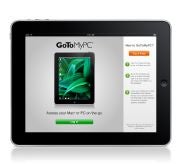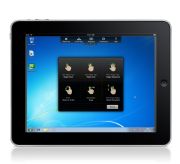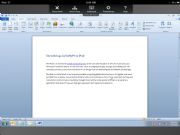Good idea to keep everything flowing with the Ipad
Hands On with GoToMyPC for iPad App
The iPad is an awesome mobile computing tool, and it can take the place of a PC for most tasks, but when push comes to shove, it's still not a PC.
Citrix is bridging that gap, though, by enabling users to remotely
connect to and work with their PC on the go from an iPad using the
GoToMyPC for iPad app.
The iPad, in and of itself, is an awesome mobile computing platform for business. It is lighter and more portable than a laptop,
has exceptional battery life, and works like a charm for e-mail, Web
surfing, and many other common tasks. Inevitably, though, there will be
some special software or proprietary application that doesn't have an
iPad app equivalent and requires the actual PC.

 A
Citrix press release describes the new app. "GoToMyPC for iPad provides
a fast, easy and secure way to instantly connect over the Internet to a
host Mac or PC from an iPad, allowing people to access and work on
their data, files, network and applications."
A
Citrix press release describes the new app. "GoToMyPC for iPad provides
a fast, easy and secure way to instantly connect over the Internet to a
host Mac or PC from an iPad, allowing people to access and work on
their data, files, network and applications."
Lisa Reeves, vice president and general manager of Access and Cloud, Citrix Online, explains, "Today's workforce wants the ease and flexibility to work wherever it's most optimal. Regardless of where people choose to work, this transition to mobility requires secure, high-performing and reliable technology to help them be effective and productive."
So, let's check it out and see how it works in the real world.
My Experience with GoToMyPC for iPad
I installed the GoToMyPC for iPad app on my iPad to see how it works. First, I had to actually install GoToMyPC on my laptop. The iPad app is free, but it only works if you are running GoToMyPC in the first place. The subscription for GoToMyPC service starts at $10 per month per PC, but I signed up for the free 30-day evaluation.
When you install GoToMyPC, you must create an account login for the service, and a unique access code for the specific PC. So, with GoToMyPC installed and running on my laptop, and with the GoToMyPC app installed on my iPad, I was ready to give it a whirl.
The first thing you see after you tap on the GoToMyPC app icon is a login screen. You must enter the e-mail address and password for the GoToMyPC account to connect to the service. Once connected, the app will display any PCs associated with your account that are running GoToMyPC and are available to connect to.

 I
tapped the "Connect" button for my laptop. A pop-up alert on the laptop
let me know that the display settings were changed--apparently,
GoToMyPC doesn't work well with the Aero display on Windows 7. After I
entered the unique access code I had created to establish the remote
session with my laptop, the iPad displayed my Windows 7 desktop. Voila!
I
tapped the "Connect" button for my laptop. A pop-up alert on the laptop
let me know that the display settings were changed--apparently,
GoToMyPC doesn't work well with the Aero display on Windows 7. After I
entered the unique access code I had created to establish the remote
session with my laptop, the iPad displayed my Windows 7 desktop. Voila!
A pop-up window on the iPad displays illustrations of the gestures to use with GoToMyPC and what they do. Citrix took advantage of the multi-touch gestures to incorporate the ability to right-click, scroll, or toggle the keyboard off and on using your fingers on the iPad display.
GoToMyPC works in either portrait or landscape orientation, but it fits the screen much more nicely in landscape mode. Once connected, I had no problem accessing any of the applications installed, or data stored on my Windows 7 laptop. I was even able to open Microsoft Windows and type part of this article remotely using the GoToMyPC for iPad app.

There is a brief lag updating the display on the iPad, but if you weren't sitting with both the iPad and your laptop directly in front of you like I was, you probably wouldn't really notice. The preferences for the app allow you to customize your experience regarding how your PC is displayed on the iPad, how sounds from the PC are handled, and managing the balance between speed and performance. You can also set security settings to blank the host screen and disable the host keyboard and mouse while the remote session is active on the iPad.
The press release for GoToMyPC for iPad sums it up nicely: "The need for flash drives, print-outs and late nights at the office is no longer necessary--with GoToMyPC, everything you need is now just a few taps away."
I think that it would be awesome to have GoToMyPC running on my laptop as an insurance plan. If I happen to be roaming about with my iPad and suddenly need access to applications or data on my laptop, it would be nice to jump in remotely and get it. I haven't decided yet, though, if that peace of mind is worth $10 a month.
Similar Articles:
 A
Citrix press release describes the new app. "GoToMyPC for iPad provides
a fast, easy and secure way to instantly connect over the Internet to a
host Mac or PC from an iPad, allowing people to access and work on
their data, files, network and applications."
A
Citrix press release describes the new app. "GoToMyPC for iPad provides
a fast, easy and secure way to instantly connect over the Internet to a
host Mac or PC from an iPad, allowing people to access and work on
their data, files, network and applications."Lisa Reeves, vice president and general manager of Access and Cloud, Citrix Online, explains, "Today's workforce wants the ease and flexibility to work wherever it's most optimal. Regardless of where people choose to work, this transition to mobility requires secure, high-performing and reliable technology to help them be effective and productive."
So, let's check it out and see how it works in the real world.
My Experience with GoToMyPC for iPad
I installed the GoToMyPC for iPad app on my iPad to see how it works. First, I had to actually install GoToMyPC on my laptop. The iPad app is free, but it only works if you are running GoToMyPC in the first place. The subscription for GoToMyPC service starts at $10 per month per PC, but I signed up for the free 30-day evaluation.
When you install GoToMyPC, you must create an account login for the service, and a unique access code for the specific PC. So, with GoToMyPC installed and running on my laptop, and with the GoToMyPC app installed on my iPad, I was ready to give it a whirl.
The first thing you see after you tap on the GoToMyPC app icon is a login screen. You must enter the e-mail address and password for the GoToMyPC account to connect to the service. Once connected, the app will display any PCs associated with your account that are running GoToMyPC and are available to connect to.
 I
tapped the "Connect" button for my laptop. A pop-up alert on the laptop
let me know that the display settings were changed--apparently,
GoToMyPC doesn't work well with the Aero display on Windows 7. After I
entered the unique access code I had created to establish the remote
session with my laptop, the iPad displayed my Windows 7 desktop. Voila!
I
tapped the "Connect" button for my laptop. A pop-up alert on the laptop
let me know that the display settings were changed--apparently,
GoToMyPC doesn't work well with the Aero display on Windows 7. After I
entered the unique access code I had created to establish the remote
session with my laptop, the iPad displayed my Windows 7 desktop. Voila!A pop-up window on the iPad displays illustrations of the gestures to use with GoToMyPC and what they do. Citrix took advantage of the multi-touch gestures to incorporate the ability to right-click, scroll, or toggle the keyboard off and on using your fingers on the iPad display.
GoToMyPC works in either portrait or landscape orientation, but it fits the screen much more nicely in landscape mode. Once connected, I had no problem accessing any of the applications installed, or data stored on my Windows 7 laptop. I was even able to open Microsoft Windows and type part of this article remotely using the GoToMyPC for iPad app.

There is a brief lag updating the display on the iPad, but if you weren't sitting with both the iPad and your laptop directly in front of you like I was, you probably wouldn't really notice. The preferences for the app allow you to customize your experience regarding how your PC is displayed on the iPad, how sounds from the PC are handled, and managing the balance between speed and performance. You can also set security settings to blank the host screen and disable the host keyboard and mouse while the remote session is active on the iPad.
The press release for GoToMyPC for iPad sums it up nicely: "The need for flash drives, print-outs and late nights at the office is no longer necessary--with GoToMyPC, everything you need is now just a few taps away."
I think that it would be awesome to have GoToMyPC running on my laptop as an insurance plan. If I happen to be roaming about with my iPad and suddenly need access to applications or data on my laptop, it would be nice to jump in remotely and get it. I haven't decided yet, though, if that peace of mind is worth $10 a month.
